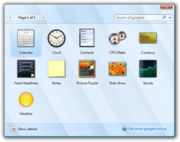
Choose a Windows Vista Capable or Premium Ready PC for the Windows Vista edition that's right for you.
Are you looking to buy a Windows XP-based computer today but want to make sure that it can run Windows Vista? There's no need to wait. When you buy a new PC that carries the Windows Vista Capable or Premium Ready PC designation, you’ll be able to upgrade to one of the editions of Windows Vista while taking advantage of all the opportunities offered by Windows XP today.
What is a Windows Vista Capable PC?
A new PC that carries the Windows Vista Capable PC logo can run Windows Vista. All editions of Windows Vista will deliver core experiences such as innovations in organizing and finding information, security, and reliability. All Windows Vista Capable PCs will run these core experiences at a minimum. Some features available in the premium editions of Windows Vista—like the new Windows Aero user experience—may require advanced or additional hardware.
A Windows Vista Capable PC includes at least:
- A modern processor (at least 800MHz).
- 512 MB of system memory.
- A graphics processor that is DirectX 9 capable.
Windows Vista Premium Ready PCs
To get an even better Windows Vista experience, including the Windows Aero user experience, ask for a Windows Vista Capable PC that is designated Premium Ready, or choose a PC that meets or exceeds the Premium Ready requirements described below. Features available in specific premium editions of Windows Vista, such as the ability to watch and record live TV, may require additional hardware.
A Windows Vista Premium Ready PC includes at least:
- 1 GHz 32-bit (x86) or 64-bit (x64) processor.
- 1 GB of system memory.
- Support for DirectX 9 graphics with a WDDM driver, 128 MB of graphics memory (minimum), Pixel Shader 2.0 and 32 bits per pixel.
- 40 GB of hard drive capacity with 15 GB free space.
- DVD-ROM Drive.
- Audio output capability.
- Internet access capability.
Read all of the Windows Vista Capable footnotes.
Review the Windows Vista minimum supported system requirements.
Windows Marketplace has a selection of Windows Vista Capable and Premium Ready PCs that are available today.
Windows Vista enterprise hardware planning guidance is available on TechNet.
Can the Windows Vista experience vary on different PCs?
Yes. Windows Vista is the first Windows operating system with a user experience that adapts to take advantage of the capabilities of the hardware on which it is installed.
All Windows Vista Capable PCs will be able to run at least the core experiences of Windows Vista.
All Windows Vista Premium Ready PCs can deliver even better Windows Vista experiences, including the new Windows Aero user experience.
Does buying a Windows Vista Capable PC mean that I will receive a free upgrade to Windows Vista?
No. A PC that is Windows Vista Capable or Premium Ready means that the PC is ready for an upgrade from Windows XP. You would still need to purchase the edition of Windows Vista that you want to install on your Windows Vista Capable or Premium Ready PC.
source: microsoft.com











 So what is Google really up to here? Is Mountain View and San Francisco just beta cities for something much bigger like national WiFi? Google has been quietly
So what is Google really up to here? Is Mountain View and San Francisco just beta cities for something much bigger like national WiFi? Google has been quietly 




